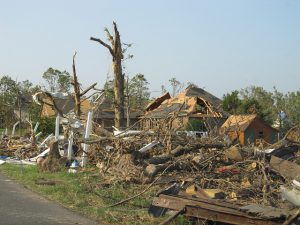While no one knows exactly which mix of factors and to what extent those factors are causing algal blooms on Lake Erie, it’s clear among the scientific community that, in the western basin, farmers are at the very least playing a significant role.
Along with sunlight, the release of soil nutrients like phosphorus and nitrogen through farm field runoff helps create environments in waterways where harmful algal blooms can form, threatening health outcomes in the area and putting a major damper on the region’s tourism and fishing industry dollars.
That’s why former Kentucky farmer, Dr. Kevin King, research leader and supervisory research agricultural engineer with the U.S. Department of Agriculture’s Agricultural Research Service-Soil Drainage Research Unit was on hand at the Williams Soil and Water Conservation District’s Field Technology Day to discuss possible solutions and to enlist farmers’ help in further understanding the problem.
According to King, testing at 80 fields across 40 sites has revealed that drainage from tiles contains a phosphorus concentration of about .05-.06 parts per million (ppm), right at the level accepted through an agreement between the U.S. and Canada.
“Our tile is just about there,” King said, noting that some individual sites rich in phosphorous do contain much higher concentrations.
However, surface flow drainage contains concentrations of about 0.2 ppm on average.
While tile drainage accounts for anywhere from 40 to 95 percent of annual discharge, surface drainage’s higher concentration remains a bigger issue, according to King.
“Concentration is what really feeds the algal bloom,” he said.
King noted that the region has had 4,500 rainfall events since 2010 and that individual rainfall events totaling 1.5 to 2 inches or more cause the loss of 60 to 70 percent of all nutrients leaving test sites.
“If we can store 1.5 to 2 inches of rain in our landscape or at the edge of the field, then we can go a long way to reduce the amount of nutrients going downstream and eventually in the lake,” King said, listing possible solutions like elevating tiles at certain times of the year and planting cover crops, though he noted those ideas may not work for everyone.
King said for every 1 percent of organic matter in soil, 3 quarters of an inch of water can be stored. Organic matter can be restored through no-till practices and manure application.
When informally polled by King about who had water management plans, of the dozens of farmers in attendance only several raised their hands. A group of farmers estimated less than 50 percent of farmers practice water management.
However, King said 93 percent of farmers in the region test their soil at least once per crop rotation. Over-application of phosphorous-containing manure over many years is believed to be a contributor to the issue. Some 5 percent of farmed acreage in the western Lake Erie basin contains phosphorous levels of 150-200 ppm.
King mentioned a farmer who hasn’t applied phosphorous in five years who haven’t seen a drop in yield.
“It’s not a large percentage of the land, but we definitely don’t (need) to be putting fertilizers on those areas,” King said. “We can’t just look at our soil tests and say, “That’s what my level is.’ We’ve got to look at what the historical crop rotation is and start taking a more holistic approach, looking at the microbial biomass as well.”
He talked about the level of nutrient loss per acre the scientific community is asking farmers to achieve.
“It’s about a quarter-pound per acre, that’s what we’re striving to get to,” King said. “That ought to scare you. If we think about what you’re applying right now, you’re applying 15, 20 pounds an acre and we’re asking you to get down to a quarter of a pound loss.
“Right now, your losses are somewhere in the 1 to 1.50 pounds (range) an acre of loss.
“We’re already doing 90 percent recovery efficiency, so what do we do now to get us down 0.25 of a pound?” he said. “That’s the margin we’re working with … It’s that quarter of a pound an acre that’s causing the lake to be green.”
He recommended putting fertilizer on just before planting, if possible.
“What I would encourage you to do is turn off the hoppers when you fertilize for 100 yards in two or three spots,” King said. “Don’t wait on the science, it’ll be four, five, six years before we figure out and get those recommendations. Convince yourself that you don’t need that much phosphorous. There’s a lot in the soil.”
Joe Nester, owner of Bryan-based Nester Ag, as well as the test field where Thursday’s Tech Day was held, encouraged independent research among farmers and stressed the importance of organic matter and the use of gypsum which has been proven to effectively create bonded phosphates which don’t leave the field as easily in drainage.
“Gypsum’s not the silver bullet — There are no silver bullets and there are no smoking guns,” King said. “We don’t know what’s causing this problem. We know that in this watershed we see dissolved phosphorus going up. We don’t know why. It’s not just an Ohio issue, it’s a world issue.”
He provided the example of algal blooms in once-pristine Colorado streams.
“In this watershed, agriculture absolutely has a role in what’s happening, but it’s not explanatory for what’s happening around the globe,” King said.
“We have to keep taking a chance of failing and put yourself out there,” Nester said. “Find that breaking point on phosphorous on you operation under your management. Find that breaking point on nitrogen so we’re not contributing.
“The answer will come from farmers, not the legislature. We have to bring the answers,” Nester said.
A few farmers present at the discussion voiced their belief that factors like animal waste, human waste from cities and the changing chemistry of (acid) rain play roles that are not commonly acknowledged by the scientific community.
Currently, there are no tangible incentives from state or federal governments for farmers to implement best practices determined by research to limit algal blooms.
When asked, several other farmers indicated by-acre incentives for best practices would help more quickly increase implementation.
 In der heutigen Zeit ist es eigentlich unerlässlich, dass jeder ein Giro- oder Gehaltskonto besitzt. Die Auswahl an solchen Konten ist mittlerweile sehr umfangreich und vielfältig. Das passende Girokonto zu finden, kann aus diesem Grund sehr schwierig und zeitaufwändig sein. Bevor Sie sich für Sie sich für ein Konto entscheiden, sollten Sie auf alle Fälle einen kostenlosen Vergleich durchführen. Alle verfügbaren Giro- und Gehaltskonten finden Sie natürlich mit wenigen Klicks im Internet und auch die dazugehörenden Test- und Vergleichsberichte sollten rasch zu finden sein. Besonders beliebt sind Gehalts- oder Girokonten bei Direktbanken. Eine Vielzahl der Kunden wickelt seine Finanzen selbst ab und benötigt in den meisten Fällen keinen Bankmitarbeiter mehr. Direktbanken haben einen Vorteil, denn sie können die Produkte aus dem Finanzbereich in den meisten Fällen zu deutlich besseren Konditionen anbieten. Ob nun ein Konto von der DKB, 1822direkt oder von der Norisbank, Sie haben sozusagen die Qual der Wahl, wenn es um ein Gehalts- oder Girokonto geht. Die zuvor genannten Banken gehören auch zu den beliebtesten auf dem Finanzmarkt.
In der heutigen Zeit ist es eigentlich unerlässlich, dass jeder ein Giro- oder Gehaltskonto besitzt. Die Auswahl an solchen Konten ist mittlerweile sehr umfangreich und vielfältig. Das passende Girokonto zu finden, kann aus diesem Grund sehr schwierig und zeitaufwändig sein. Bevor Sie sich für Sie sich für ein Konto entscheiden, sollten Sie auf alle Fälle einen kostenlosen Vergleich durchführen. Alle verfügbaren Giro- und Gehaltskonten finden Sie natürlich mit wenigen Klicks im Internet und auch die dazugehörenden Test- und Vergleichsberichte sollten rasch zu finden sein. Besonders beliebt sind Gehalts- oder Girokonten bei Direktbanken. Eine Vielzahl der Kunden wickelt seine Finanzen selbst ab und benötigt in den meisten Fällen keinen Bankmitarbeiter mehr. Direktbanken haben einen Vorteil, denn sie können die Produkte aus dem Finanzbereich in den meisten Fällen zu deutlich besseren Konditionen anbieten. Ob nun ein Konto von der DKB, 1822direkt oder von der Norisbank, Sie haben sozusagen die Qual der Wahl, wenn es um ein Gehalts- oder Girokonto geht. Die zuvor genannten Banken gehören auch zu den beliebtesten auf dem Finanzmarkt.
 In der heutigen Zeit ist es eigentlich unerlässlich, dass jeder ein Giro- oder Gehaltskonto besitzt. Die Auswahl an solchen Konten ist mittlerweile sehr umfangreich und vielfältig. Das passende Girokonto zu finden, kann aus diesem Grund sehr schwierig und zeitaufwändig sein. Bevor Sie sich für Sie sich für ein Konto entscheiden, sollten Sie auf alle Fälle einen kostenlosen Vergleich durchführen. Alle verfügbaren Giro- und Gehaltskonten finden Sie natürlich mit wenigen Klicks im Internet und auch die dazugehörenden Test- und Vergleichsberichte sollten rasch zu finden sein. Besonders beliebt sind Gehalts- oder Girokonten bei Direktbanken. Eine Vielzahl der Kunden wickelt seine Finanzen selbst ab und benötigt in den meisten Fällen keinen Bankmitarbeiter mehr. Direktbanken haben einen Vorteil, denn sie können die Produkte aus dem Finanzbereich in den meisten Fällen zu deutlich besseren Konditionen anbieten. Ob nun ein Konto von der DKB, 1822direkt oder von der Norisbank, Sie haben sozusagen die Qual der Wahl, wenn es um ein Gehalts- oder Girokonto geht. Die zuvor genannten Banken gehören auch zu den beliebtesten auf dem Finanzmarkt.
In der heutigen Zeit ist es eigentlich unerlässlich, dass jeder ein Giro- oder Gehaltskonto besitzt. Die Auswahl an solchen Konten ist mittlerweile sehr umfangreich und vielfältig. Das passende Girokonto zu finden, kann aus diesem Grund sehr schwierig und zeitaufwändig sein. Bevor Sie sich für Sie sich für ein Konto entscheiden, sollten Sie auf alle Fälle einen kostenlosen Vergleich durchführen. Alle verfügbaren Giro- und Gehaltskonten finden Sie natürlich mit wenigen Klicks im Internet und auch die dazugehörenden Test- und Vergleichsberichte sollten rasch zu finden sein. Besonders beliebt sind Gehalts- oder Girokonten bei Direktbanken. Eine Vielzahl der Kunden wickelt seine Finanzen selbst ab und benötigt in den meisten Fällen keinen Bankmitarbeiter mehr. Direktbanken haben einen Vorteil, denn sie können die Produkte aus dem Finanzbereich in den meisten Fällen zu deutlich besseren Konditionen anbieten. Ob nun ein Konto von der DKB, 1822direkt oder von der Norisbank, Sie haben sozusagen die Qual der Wahl, wenn es um ein Gehalts- oder Girokonto geht. Die zuvor genannten Banken gehören auch zu den beliebtesten auf dem Finanzmarkt.
 Ein Homepage Baukasten eignet sich besonders für Selbständige und Unternehmen. Hiermit kann ohne Kenntnisse im Bereich der Programmierung eine eigene Webseite erstellt werden. Zudem ist der Aufbau deutlich günstiger, als wenn ein professioneller Webdesigner diese Arbeit übernehmen würde.
Ein Homepage Baukasten eignet sich besonders für Selbständige und Unternehmen. Hiermit kann ohne Kenntnisse im Bereich der Programmierung eine eigene Webseite erstellt werden. Zudem ist der Aufbau deutlich günstiger, als wenn ein professioneller Webdesigner diese Arbeit übernehmen würde. Mit der Nutzung von
Mit der Nutzung von  In vielen Haushalten reicht das Einkommen einfach nicht mehr aus. Die Kosten für den Lebensunterhalt sind in den letzten Jahren regelrecht explodiert. Wen unerwartete Ausgaben treffen oder wer sich einen Traum erfüllen möchte, ist zumeist auf das Geld von einem Kredit angewiesen. Ein Onlinekredit mit Sofortzusage ist für viele die perfekte Lösung, doch wie einfach ist es heute einen Kredit zu bekommen und auf was muss geachtet werden?
In vielen Haushalten reicht das Einkommen einfach nicht mehr aus. Die Kosten für den Lebensunterhalt sind in den letzten Jahren regelrecht explodiert. Wen unerwartete Ausgaben treffen oder wer sich einen Traum erfüllen möchte, ist zumeist auf das Geld von einem Kredit angewiesen. Ein Onlinekredit mit Sofortzusage ist für viele die perfekte Lösung, doch wie einfach ist es heute einen Kredit zu bekommen und auf was muss geachtet werden? einen Kredit bewilligt zu bekommen. Das Angebot ist sehr vielseitig und wer sich mit dem Thema
einen Kredit bewilligt zu bekommen. Das Angebot ist sehr vielseitig und wer sich mit dem Thema  Ein weiterer Vorteil von den Krediten über das Internet ist, dass sie zumeist keinem bestimmten Verwendungszweck unterliegen. Somit können Sie mit dem gewährten Kreditbetrag offene Rechnungen bezahlen, die Wohnung renovieren, das Fahrzeug reparieren oder sich einen Urlaub mit der Familie gönnen. Verabschieden Sie sich von Ihren finanziellen Sorgen und füllen Sie bei einem der Kreditanbieter einfach das Online Formular für den Kreditantrag aus. Sofern Sie die Vorgaben und Bedingungen des Kreditinstitutes erfüllen, erfolgt die Auszahlung innerhalb weniger Stunden.
Ein weiterer Vorteil von den Krediten über das Internet ist, dass sie zumeist keinem bestimmten Verwendungszweck unterliegen. Somit können Sie mit dem gewährten Kreditbetrag offene Rechnungen bezahlen, die Wohnung renovieren, das Fahrzeug reparieren oder sich einen Urlaub mit der Familie gönnen. Verabschieden Sie sich von Ihren finanziellen Sorgen und füllen Sie bei einem der Kreditanbieter einfach das Online Formular für den Kreditantrag aus. Sofern Sie die Vorgaben und Bedingungen des Kreditinstitutes erfüllen, erfolgt die Auszahlung innerhalb weniger Stunden.

